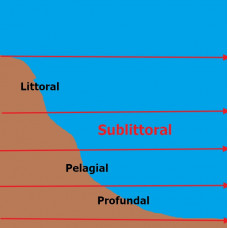From Latin sub - under and litoralis - coastal.
Sublittoral is a coastal shallow-water zone extending from the lower boundary of the littoral to the upper boundary of the profundal. In seas and oceans it usually extends to the lower boundary of bottom plants spreading - from 40 m to 200 m; in lakes to the depth of 10-12 m. In the sublittoral zone, wave action and temperature changes are less pronounced. The sublittoral is the most populated area. The main stocks of marine and freshwater fish and commercial invertebrates are concentrated there.
The most biologically rich zone of the sea, where representatives of all major systematic groups of marine organisms live. The upper, well-lit part of the sublittoral - phytale (up to 30-50 m depth) of temperate and cold waters is characterised by thickets of green, brown and red algae - macrophytes. Strong thickets (up to 10 kg/m2 and more) are formed by brown (laminaria, fucus), sometimes red (phyllophora, lithothamnion) algae, as well as sea grasses (broomrape or zostera, etc.). Numerous molluscs, crustaceans, echinoderms, polychaetes, etc. live in the thickets. The rocky substrate is colonised by benthic diatoms, sponges, hydroids, bryozoans, sea acorns, etc.
In the tropics, the upper sublittoral is characterised by a highly productive coral reef biocenosis. With increasing depth, vegetation disappears and biomass decreases. In the upper sublittoral, total benthic biomass can reach 10-15 kg/m2, while in the lower sublittoral it is usually in the hundreds of g/m2 or less. In polar regions, sponges, bryozoans and ascidians are abundant in the sublittoral. The sublittoral is also isolated in lakes.
Sublittoral
Tags: sublittoral

